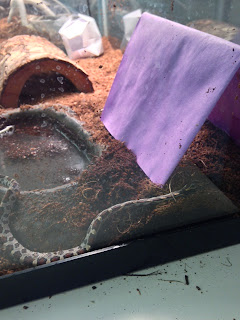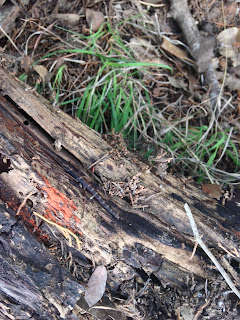 To start off, an amazing experience happened just today. One of my previous students Jayden (boy), who is also a current student of Mr. Brooks, greeted me at my classroom door this morning. He had a shoe box which contained an unidentified bird. He told me that he and his family had discovered this bird being attacked in an ant pile. He decided to rescue the bird, clean it of the ants, and bring it into class. His brother had rescued a squirrel 2 years earlier and had brought that into class. Mr. Matthews and other students helped nurture that squirrel to eventually release it back outdoors. Mr. Matthews had this wonder phrase: Novices think I am an Expert, and Experts know that I am a Novice. When I saw Jayden's bird I knew what to do, but I getting started was the problem. I didn't know what the bird's condition was, and did not want to do anything to worsen it. We attempted to identify the bird, but had difficulties not knowing where to look due to the limited information we had about the bird. We ended up contacting Austin Wildlife Rescue (http://austinwildliferescue.org/). I left a message describing what had happened and waited for a response. Luckily they called back and recommmended I bring in the bird due to its ant bites. Normally with a fledling, you would leave it where it was found because the bird is learning to walk and fly with help from its parents. When Wildlife Rescue's Madeline examined the bird, she said it would do fine. Jayden's quick reaction saved a bird from a very painful death. The bird actually turned out to be a fledgling dove. I spoke with Madeline for a while to find out what would be next for our bird. It was going to spend some time in an incubator being fed. Once the dove is able to eat, walk, and fly on its own, it would be removed to a flight cage. Where it will get more experience flying. Once ready it will be released back into the wild. Way to go JAYDEN!
To start off, an amazing experience happened just today. One of my previous students Jayden (boy), who is also a current student of Mr. Brooks, greeted me at my classroom door this morning. He had a shoe box which contained an unidentified bird. He told me that he and his family had discovered this bird being attacked in an ant pile. He decided to rescue the bird, clean it of the ants, and bring it into class. His brother had rescued a squirrel 2 years earlier and had brought that into class. Mr. Matthews and other students helped nurture that squirrel to eventually release it back outdoors. Mr. Matthews had this wonder phrase: Novices think I am an Expert, and Experts know that I am a Novice. When I saw Jayden's bird I knew what to do, but I getting started was the problem. I didn't know what the bird's condition was, and did not want to do anything to worsen it. We attempted to identify the bird, but had difficulties not knowing where to look due to the limited information we had about the bird. We ended up contacting Austin Wildlife Rescue (http://austinwildliferescue.org/). I left a message describing what had happened and waited for a response. Luckily they called back and recommmended I bring in the bird due to its ant bites. Normally with a fledling, you would leave it where it was found because the bird is learning to walk and fly with help from its parents. When Wildlife Rescue's Madeline examined the bird, she said it would do fine. Jayden's quick reaction saved a bird from a very painful death. The bird actually turned out to be a fledgling dove. I spoke with Madeline for a while to find out what would be next for our bird. It was going to spend some time in an incubator being fed. Once the dove is able to eat, walk, and fly on its own, it would be removed to a flight cage. Where it will get more experience flying. Once ready it will be released back into the wild. Way to go JAYDEN!
We have had great opportunities for the kids to get up close with some native and non-native species.We have the corn snake, Kaleidoscope/Sasha, that Mr. Brooks showed in his previous post. When she got out we got another corn snake, Klein. Sadly she got sick and wouldn't eat, but the kids loved holding her while we had her.
In preparation for the Plant Sale we had to organize near the greenhouse. While doing this we were able to find a few spiny lizards living under a pile of wood.
Having this spiny lizard in our class allowed us to experience our nature trail in a completely different way. We became cricket hunters. In the process we saw a lot of cool things outside we may have never seen.
The crickets were hiding underneath different flat heavy objects. We check under wood logs and found a plethora of invertebrates. Here we found a walking stick.
We found so many scorpions! Under every rock in a handmade staircase there were at least two.
We got up close with a cardinal nest. The mother kept flying off as I was trying to get close to get a shot. In the process we noticed that there was a bird singing every time we got close to the nest. It turns out that the male was sitting on a telephone wire above us warning the female we were near. Each time we looked at him he flew off. We went back and forth watching the male and female interacing in this way. It was truly a behavior that we had not been able to observe especially for such a long period of time.
 |
| Purple Martin Nest with eggs |
 |
| Purple Martin Fledgling |
 ABOVE: House Sparrow nest in gourd, LOWER: House sparrow nest on ground
|
Luckily we also get to experience watching the cycle of life. We have watched nest building, egg laying, and now purple martins growing and getting ready for a new life on their own. We currently have over 40 eggs, hatchlings, or fledlings.
My last photos are extras of our pond and tool shed projects. They have been the big projects this semester in my classes
The pond is almost done! This has been a project that has taken a whole year to complete. Within the next few weeks we will have power. Once power is installed, we need to finish our waterfall and basin. This will allow us to have a second ecosystem to study. It is really exciting.
The year and semester has blown by. All we can hope for is that next year will go as well.

















No comments:
Post a Comment
Thank you for commenting. Your comment will be reviewed.